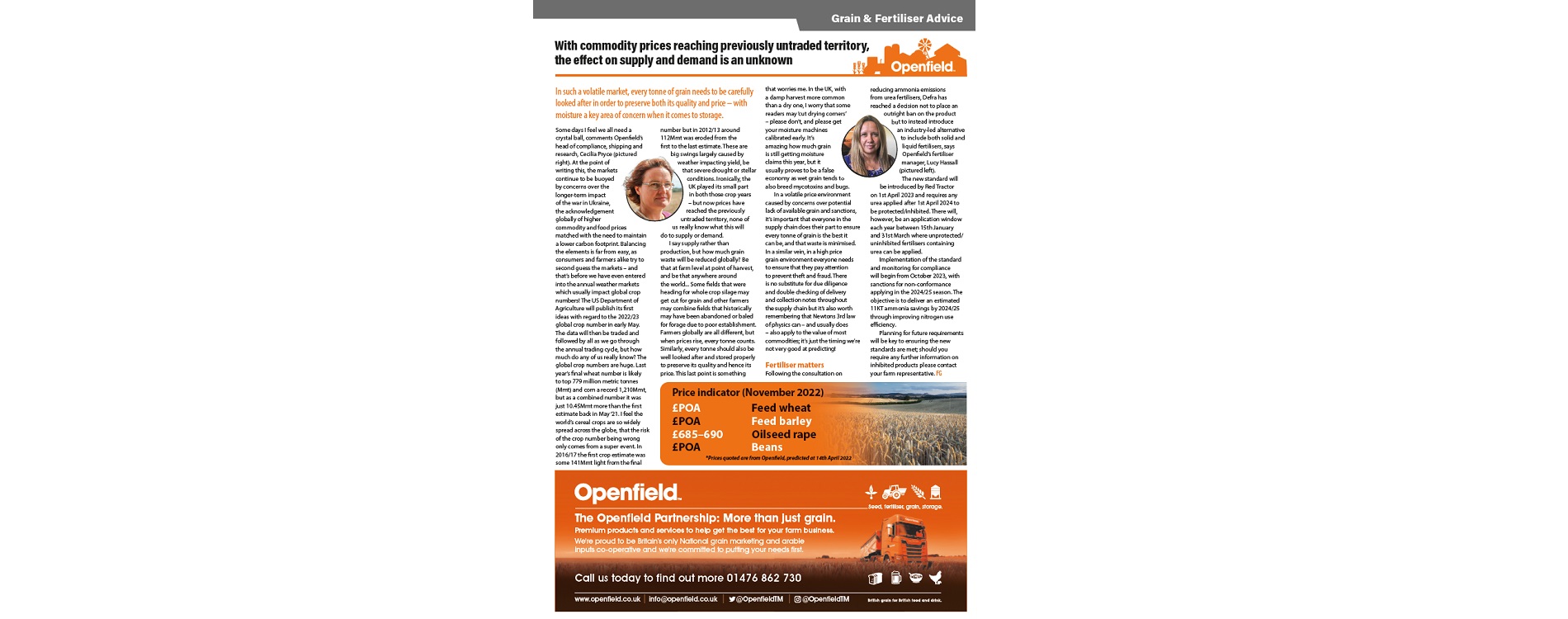With commodity prices reaching previously untraded territory, the effect on supply and demand is an unknown
In such a volatile market, every tonne of grain needs to be carefully looked after in order to preserve both its quality and price – with moisture a key area of concern when it comes to storage.
Some days I feel we all need a crystal ball, comments Openfield’s head of compliance, shipping and research, Cecilia Pryce. At the point of writing this, the markets continue to be buoyed by concerns over the longer-term impact of the war in Ukraine, the acknowledgement globally of higher commodity and food prices matched with the need to maintain a lower carbon footprint. Balancing the elements is far from easy, as consumers and farmers alike try to second guess the markets – and that’s before we have even entered into the annual weather markets which usually impact global crop numbers! The US Department of Agriculture will publish its first ideas with regard to the 2022/23 global crop number in early May. The data will then be traded and followed by all as we go through the annual trading cycle, but how much do any of us really know? The global crop numbers are huge. Last year’s final wheat number is likely to top 779 million metric tonnes (Mmt) and corn a record 1,210Mmt, but as a combined number it was just 10.45Mmt more than the first estimate back in May ‘21. I feel the world’s cereal crops are so widely spread across the globe, that the risk of the crop number being wrong only comes from a super event. In 2016/17 the first crop estimate was some 141Mmt light from the final number but in 2012/13 around 112Mmt was eroded from the first to the last estimate. These are big swings largely caused by weather impacting yield, be that severe drought or stellar conditions. Ironically, the UK played its small part in both those crop years – but now prices have reached the previously untraded territory, none of us really know what this will do to supply or demand.
I say supply rather than production, but how much grain waste will be reduced globally? Be that at farm level at point of harvest, and be that anywhere around the world… Some fields that were
heading for whole crop silage may get cut for grain and other farmers may combine fields that historically may have been abandoned or baled for forage due to poor establishment. Farmers globally are all different, but when prices rise, every tonne counts. Similarly, every tonne should also be well looked after and stored properly to preserve its quality and hence its price. This last point is something that worries me. In the UK, with a damp harvest more common than a dry one, I worry that some readers may ‘cut drying corners’ – please don’t, and please get your moisture machines calibrated early. It’s amazing how much grain is still getting moisture claims this year, but it usually proves to be a false economy as wet grain tends to also breed mycotoxins and bugs.
In a volatile price environment caused by concerns over potential lack of available grain and sanctions, it’s important that everyone in the supply chain does their part to ensure every tonne of grain is the best it can be, and that waste is minimised. In a similar vein, in a high price grain environment everyone needs to ensure that they pay attention to prevent theft and fraud. There is no substitute for due diligence and double checking of delivery and collection notes throughout the supply chain but it’s also worth remembering that Newtons 3rd law of physics can – and usually does – also apply to the value of most commodities; it’s just the timing we’re not very good at predicting!
Fertiliser matters
Following the consultation on reducing ammonia emissions from urea fertilisers, Defra has reached a decision not to place an outright ban on the product but to instead introduce an industry-led alternative to include both solid and liquid fertilisers, says Openfield’s fertiliser manager, Lucy Hassall.
The new standard will be introduced by Red Tractor on 1st April 2023 and requires any urea applied after 1st April 2024 to be protected/inhibited. There will, however, be an application window
each year between 15th January and 31st March where unprotected/uninhibited fertilisers containing urea can be applied.
Implementation of the standard and monitoring for compliance will begin from October 2023, with sanctions for non-conformance applying in the 2024/25 season. The objective is to deliver an estimated 11KT ammonia savings by 2024/25 through improving nitrogen use effciency.
Planning for future requirements will be key to ensuring the new standards are met; should you require any further information on inhibited products please contact your farm representative.




